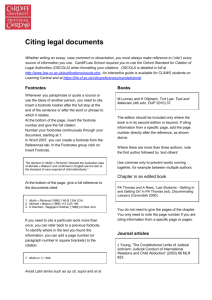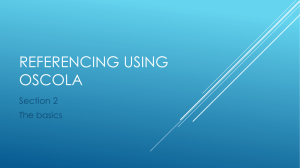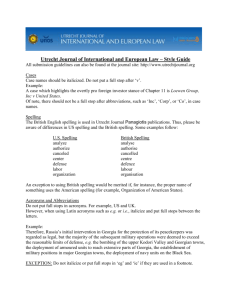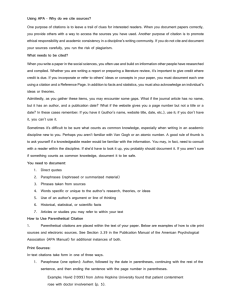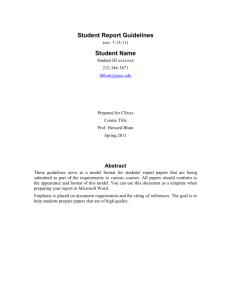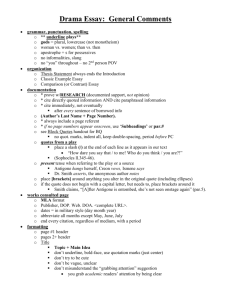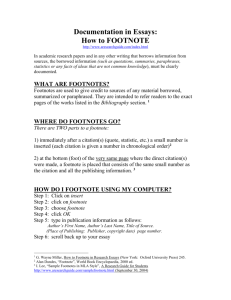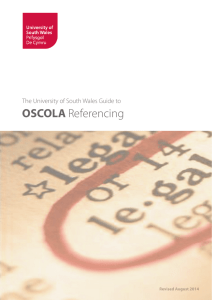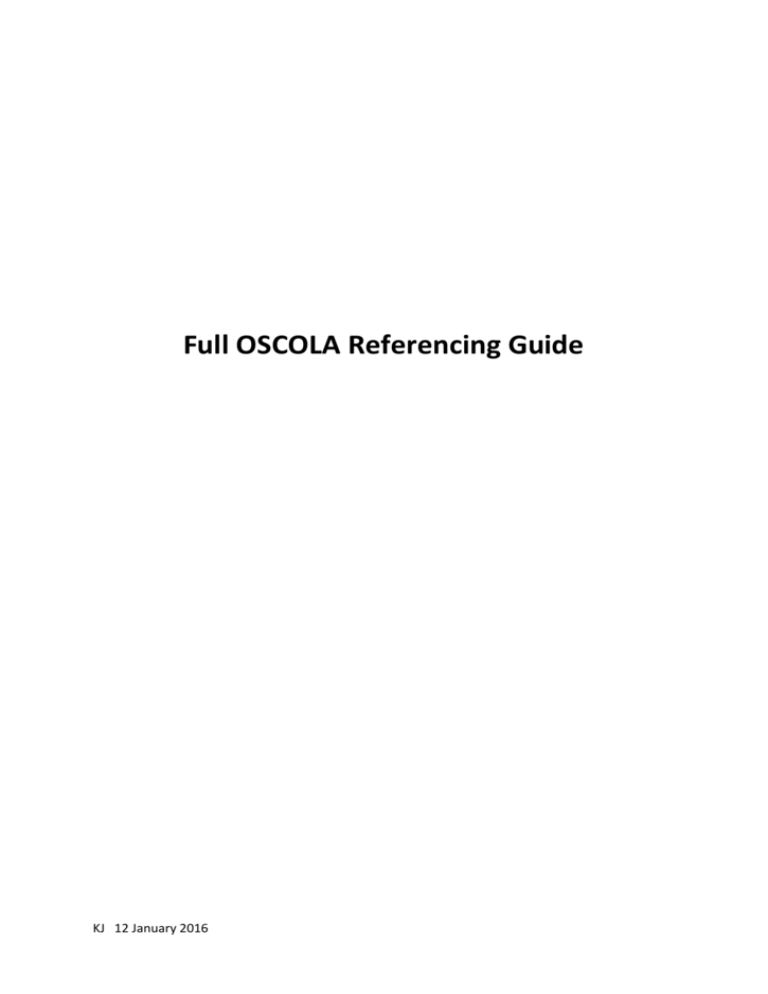
Full OSCOLA Referencing Guide
KJ 12 January 2016
Referencing Guide for OSCOLA (Oxford Standard for Citation of Legal
Authorities)
What is referencing?
Referencing is acknowledging the sources you consulted when writing your assignment or
dissertation. You must acknowledge the source within the text, and within footnotes, and
give full details of each item consulted in a bibliography (where required).
The style of referencing most commonly used to cite (reference) both primary and
secondary legal material is called OSCOLA. This is the style approved by the College of Law.
OSCOLA was originally developed for use within Oxford University, but is now used by
schools in the UK and overseas, and by many legal journals and publishers.
Why is referencing important?
Referencing is a vital part of academic research and writing. Some of the most important
reasons are the following:
To avoid plagiarism. Plagiarism means using someone else’s ideas, written or
otherwise, but passing them off as your own. Plagiarism is taken very seriously by
the University and can be very severely punished.
To provide your reader with the details needed to locate the original documents
used in your research.
To enable the examiner to check your sources to make sure that your information is
correct.
To demonstrate to the examiner that you have read a wide variety of materials and
that your research is credible.
Footnotes
The OSCOLA system is a footnote style and therefore uses footnotes for referencing
at the bottom of each page or at the end of the document before the bibliography.
When citing any source, regardless of whether you are quoting or paraphrasing the
information, cite the reference in the footnote.
Provide a footnote the first time a source is referred to.
When quoting the authors’ words exactly, use quotation marks as well as a footnote.
Keep footnotes brief as they should only be used to identify the sources used in your
text .
Each footnote should start with a capital letter unless using an abbreviation such as
i.e. which should always be in lower case, and use a full stop at the end of the
footnote.
KJ 12 January 2016
Quotations
Quotations from journals, books, cases, statutes and so on, must always be exactly
the same as they are in the original source.
The numeric reference should be placed at the end of the quote, with the footnote
to which it relates at the bottom of the page.
Short quotations (3 lines or less) are incorporated into the text itself, within single
quotation marks.
Herring gives the definition of voluntary manslaughter as a situation where ‘the defendant
would be guilty of murder but for the existence of a special defence.’ 1
The footnote at the bottom of the page should read:
1 Jonathan Herring Criminal Law: the Basics (Routledge 2010) 37
Long quotations (3 lines or more) should be written as a separate paragraph within
the body of the text. The quotation should be a single-spaced paragraph indented
from both sides of the margin. Do not use any quotation marks.
If you skip words or sentences within a quote, use three dots (…) in place of where
the text would be.
Elliott and Quinn explain the different types of nuisance in tort:
There are actually three types of nuisance: private, public and statutory. Private
nuisance is a common law tort and the main subject of this chapter. Public
nuisance is a crime ... but it also comes into the study of tort because there are
some cases where parties who have suffered as a result of a public nuisance can
sue in tort.2
The footnote at the bottom of the page should read:
2 Catherine Elliott and Frank Quinn Tort Law (Elliott and Quinn Series 7th edn, Pearson
Longman 2009) 281.
Paraphrasing
Paraphrasing is re-writing another persons’ ideas or statements in your own words
rather than quoting their words exactly.
You must still reference the original source including the page number.
If it can be proved that the victim was justifiably fearful that the defendant would use
violence against him in the immediate future, the defendant can be charged with assault. 4
The footnote at the bottom of the page should read:
4 Jonathan Herring Criminal Law: the Basics (Routledge 2010) 57
KJ 12 January 2016
Summarising
Summarising means creating a shorter version of somebody else’s work by only
mentioning the main points and leaving out much of the detail.
As with paraphrasing, the original source must be referenced.
Herring explains how criminal law differs in theory and in reality. In reality criminals
frequently aren’t caught, there may be a lack of evidence to convict them, or the authorities
may choose not to prosecute for various reasons.12
The footnote at the bottom of the page should read:
12 Jonathan Herring Criminal Law: the Basics (Routledge 2010)
Secondary Referencing
Secondary referencing is when you find information that you want to use from an
article whose author uses information from research done by someone else.
Secondary referencing is discouraged as it is much better to find the original article
yourself and evaluate it as to whether its content is relevant or not.
However, sometimes it may not be possible to locate the original article, and if you
trust the reliability of the secondary source, you can cite it.
In that case, use the word “citing” to refer to both sources. Cite the source you’ve
consulted first followed by the original source.
Brian Yeats and Jack Duggan, Water Law (Poole Press, Exeter 2009) 245 citing Atkinson v
Moore [2012] IPR 245
In your reference list/bibliography, only add the source that you referred to directly.
How do I reference using OSCOLA 4th ed.?
Below are some examples of how to cite primary and secondary legal material such as
books, journals, Acts, cases, official publications, and on-line resources using OSCOLA. For a
complete and comprehensive guide, go to the OSCOLA website at www.law.ox.ac.uk/oscola.
Books
To cite a book give the author(s), | title of book in Italics | (series title, | edition, |
publisher | date of publication) | page.
Capitalise all of the major words in the title.
Only use the edition number if it is the 2nd edition onwards.
Do not use full stops in abbreviations.
KJ 12 January 2016
Books with one author
Jonathan Herring, Criminal Law (7th edn, Macmillian 2011) 251
Gareth Jones, Goff and Jones: The Law of Restitution (1st supp, 7th edn, Sweet & Maxwell
2009)
Book with two or three authors
Hugh Jones and Christopher Benson, Publishing Law (4th edn, Routledge 2011)
Book with four or more authors
Roy Goode and others, Transnational Commercial Law : International Instruments and
Commentary (OUP 2004)
Books with editor(s) or translator(s), INSTEAD OF an author
Phil Huxley (ed), Blackstone’s Statutes on Evidence (Blackstone’s Statutes, 11th edn, OUP
2010
Peter Birks and Grant McLeod (trs), The Institutes of Justinian (Duckworth 1987)
Books with an author AND an editor or translator
HLA Hart, Punishment and Responsibility: Essays in the Philosophy of Law (John Gardner ed,
2nd edn, OUP 2008)
Karl Zweigert and Hans Kotz, An Introduction to Comparative Law (Tony Weir tr, 3rd edn,
OUP 1998)
Repeating citations – Ibid
ibid (short for ibidem) refers to a source that was cited in the preceding footnote.
The footnote at the bottom of the page should read:
12 Jonathan Herring, Medical Law and Ethics (4th edn, Oxford University Press 2012) 146.
13 Ibid 360.
Because Latin words such as supra, op cit and ante are not widely understood and
are easily misused, OSCOLA recommends avoiding them if possible.
KJ 12 January 2016
It is equally acceptable to repeat the immediately preceding citation without using
ibid by using “n” followed by the number to refer to an earlier footnote.
The footnote at the bottom of the page should read:
3 Jonathan Herring, Medical Law (OUP 2011) 52.
6 Herring (n 3) 125.
Whichever method you use, stick to it throughout your document.
Journals
Paper copy journal articles
To cite a journal article give the author, | ‘title within single quotation marks’ | (date
of publication) | volume | journal name or abbreviation | first page of article
Use round brackets when the volumes of the journal series are independently
numbered so that the year of publication is not needed to identify the volume.
If there is NO volume number, use square brackets [1985] for the date.
Capitalise all of the major words in the title.
Do not use full stops in abbreviations or within the title of the journal.
Abbreviations for journals title can be used (see appendix of OXCOLA guidelines for a
full list of abbreviations) but be consistent when using them.
Mary George, ‘Fisheries Protections in the Context of the Geo-Political Tensions in the South
China Sea’ (2012) 43 Journal of Maritime Law and Practice 85
Jeremy Waldron, ‘The Core of the Case against Judicial Review’ (2006) 115 Yale LJ 1346,
1372
James Goodwin, ‘The Last Defence of Wednesbury’ [2012] PL 445
Online Journal articles
If both the online source and paper copy are available, follow the referencing style
for the paper copy version.
When citing online articles use the same format as for the hard copy journals but
follow the citation with the web address and the date you most recently accessed
the article.
James Gobert, ‘The Corporate Manslaughter and Corporate Homicide Act 2007: Thirteen
Years in the Making but was it Worth the Wait?’ (2008) 71 MRL 413
<http://www.jstor.org/stable/25151209> accessed 15 Jan 2014
KJ 12 January 2016
Cases, Legislation and Reports
Do not use full stops in abbreviations.
When the year is crucial to identify the law report volume use square brackets. Also
give a volume number if there was more than one volume published during that
year.
Give the year of judgement in round brackets when the volumes of the law report
series are independently numbered so that the year of publication is not needed to
identify the volume.
Cases with a neutral citation
Cases which have been heard since 2001 will have a neutral citation which indicates
in which court the case was heard.
To cite a case with neutral citation give the name of the case in italics |[year of
judgement] | court | number, | [year of publication] OR (year of judgement) |
volume | report abbreviation | first page
Corr v IBC Vehicles Ltd [2008] UKHL 13, [2008] 1 AC 884
Cases without a neutral citation
To cite a case without a neutral citation give the name of the case in italics| [year]
OR (year of judgement) |volume |report abbreviation |first page | (court)
Chapman v Honig [1963] 2 QB 502 (CA)
UCB Bank plc v Chandler (1999) 79 P & CR 270 (CA)
Unreported cases
With unreported cases use the neutral citation, if there is one.
If there is no neutral citation, give the court and date of judgment in brackets after
the name of the case.
It is not necessary to add the word ‘unreported’ to the citation.
Calvert v Gardiner [2002] EWHC 1894 (QB)
Stubbs v Sayer (CA, 8 November 1990)
KJ 12 January 2016
Statutes and statutory instruments
To cite a statute give the short title | year.
To cite a section of a statute give the short title | year, | s | space |section
number(subsection)(paragraph).
Act of Supremacy 1558
Human Rights Act 1998, s 15(1)(b)
For older statutes, it may be helpful to give the regnal year and chapter number in
brackets, in addition to the title and year of the Act.
The example below shows that the Act received royal assent in the 41 st year of the
reign of George III. The abbreviation ‘c’ is for chapter and this means that it was the
90th Act to receive royal assent in that session of Parliament.
Crown Debts Act 1801 (41 Geo 3 c 90)
To cite a statutory instrument give the name, | year, | SI number
Penalties for Disorderly Behaviour (Amendment of Minimum Age) Order 2004, SI 2004/3166
Bills
To cite a Bill give the title | HC Bill | (session) | [number] OR title | HL Bill | (session)
| number
If the Bill originates in the House of Commons, put the running number in square
brackets. If it is from the House of Lords, do not put any brackets around the
number.
When referring to parts of Bills, the words ‘clause’ and ‘clauses’ should be
abbreviated to ‘cl’ and ‘cls’.
Consolidated Fund HC Bill (2008-09) [5]
Academies HL Bill (2010-11) cl 8(2)
Official (Government) Publications
An official publication is any document issued by an organisation that may be
considered an official body, and then made available to the public. This includes
command papers, White and Green papers, relevant treaties, government responses
to select committee reports, and reports of committees of inquiry, and Law
Commission Reports.
To cite a report by parliamentary committee give the name of the committee as the
author, | details of the report as the title | [years of parliamentary session] | HL for
the House of Lords OR HC for the House of Commons | serial number.
KJ 12 January 2016
For publications by individual government departments give the name of
department or committee who produced the report, | title of paper in italics |
(command paper number, | year) | page or paragraph number.
Select Committee on Delegated Powers and Deregulation, 3rd Report [Session 1998-99] HL
Paper (1998-99) no 12
Home Office, Report of the Royal Commission on Capital Punishment (Cmd 8932, 1953) para
53
Law Commission Reports
To cite Law Commission reports give the title in italics | (law commission number, |
year of publication) followed by the paragraph number if needed.
Scottish Law Commission reports are cited the same way but give the Scot Law Com
number instead.
It is not necessary to give the Command paper number.
The High Court’s Jurisdiction in Relation to Criminal Proceedings (Law Com No 324, 2010)
paras 8.15 – 8.19
Level Crossings (Scot Law Com No 234, 2013)
EU Legislation and cases
To cite EU treaties and protocols give the title of the legislation including
amendments if necessary | [year of publication] | OJ series | issue/first page.
Older treaties were published in the C series. With notable exceptions, such as the
Lisbon Treaty, legislation is now published in the L series.
Consolidated Version of the Treaty on European Union [2008] OJ C115/13
Council Regulation (EC) 139/2004 on the control of concentrations between undertakings
(EC Merger Regulation) [2004] OJ L24/1, art 5
Case C – 556/07 Commission v France [2009] OJ C102/8
Newspaper Articles
To cite a newspaper article give the author, | ‘title within single quotation marks’ |
the name of the newspaper in italics | (city of publication, | date of publication) |
page number on which the article was published, if known.
KJ 12 January 2016
If the article comes from the web and there is no page number available, provide the
web address and date of access.
Jane Croft, ‘Supreme Court Warns on Quality’ Financial Times (London, 1 July 2010) 3
Sarah Knapton, ‘Bad Owners to blame for Aggressive Animals not their Breed’ The Daily
Telegraph (3 Dec. 2013) <http://www.telegraph.co.uk/lifestyle/pets/10491808/Bad-dogowners-to-blame-for-aggressive-animals-not-their-breed.html> accessed 16 January 2014
Websites
To cite websites follow the general principles for citing books, journals and
newspaper articles.
If both the online source and paper copy are available, follow the referencing style
for the paper copy version.
If no author can be identified, begin the citation with the title in the usual way. If
there is no date of publication on the website, give only the date of access.
Sarah Cole, ‘Virtual Friend Fires Employee (Naked Law, 1 May 2009) <http://www.
nakedlaw.com/2009/05/index.html> accessed 19 November 2009
Lord Bingham, ‘Keynote Address’ (Liberty conference, London, 6 June 2009)
<http://www.liberty-human-rights.org.uk/publications/3-articles-andspeeches/index.shtml> accessed 19 November 2009
Further Help
For the full OSCOLA guidelines, a full list of abbreviations and more examples
go to www.law.ox.ac.uk/OSCOLA
For help with referencing using OSCOLA, contact Law Library Team at
AHLC@swansea.ac.uk
Interactive practical exercises on how to reference using OSCOLA can be
found in Blackboard – Law Library Support – Citing the Law Practical Exercises
at https://blackboard.swan.ac.uk/bbcswebdav/pid-946567-dt-content-rid860324_2/courses/law_library/Citing%20the%20Law/tutorial/index.html.
KJ 12 January 2016

